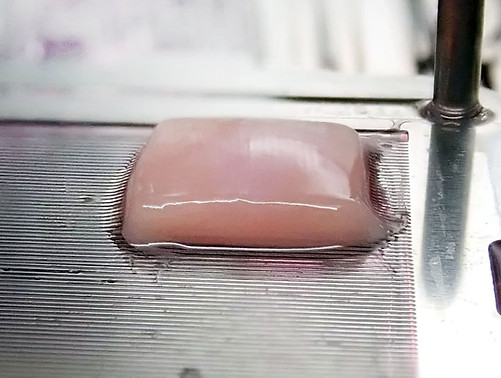
Making Real Tissue Reality
100% Cellular Tissue
TissueByNet is enabling researchers to successfully create tissues composed entirely of cells.
High-functioning, robust, and pure tissue unaffected by restrictive polymers or hydrogels are now easily created using TissueByNet Net-Engineered Tissue Technology.
NETT: Net-Engineered Tissue Technology
A Paradigm Shift in Process and Outcome
Unlike traditional 3D bioprinting extrusion techniques, TissueByNet embraces a process more likened to “bioassembly.”
By utilizing cellular spheroid constructs as intermediate building blocks between singular cells and viable tissue, TissueByNet's Net Mold technology facilitates ECM production solely through cultured cells.
These spheroids consisting purely of cultured cells mature within the net mold, simulating a more natural growth process and creating unadulterated, robust and high-functioning tissue *.
* NETT has been proven to create tissue with increased cell density, higher cell viability, as well as enhanced function and expression compared to bioprinted gel mold tissue s.
1


Results: Pure Cellular Tissue,
40mm Tube, Suturble Tissue
Net Mold construction
Step 1: (Spheroid Making)
Pour Cell Suspension into Dimple Plate and culture overnight.
Thousands of Spheroids made with Dimple Plate.
Shape of Spheroid is not a problem as long as they are large enough to be trapped by Net Mold.


Step 2: (Feed into Net Mold)
Feed Spheroids into Net Mold.
This is done manually by hand.
Culture in medium for 1-3 weeks.

Step 3: (Remove Nets)
Medium has access to cells through net spacing, enabling sufficient culture conditions for cells. Net Mold cavity holds spheroids in contact each other and secreted ECM helps cell fusion.
After culture completion, Net can be slide out easily from Cell Block.

Method
TissueByNet Net Mold: Optimize spheroid-based tissue development
Spheroid Ring: Culture spheroids from live cells
Accessories: Device
handling and culturing
Publications
A Net Mold-based Method of Biomaterial-free Three-Dimensional Cardiac Tissue Creation. Bai, Y., Yeung, E., Lui, C., Ong, CS, Pitaktong, I., Huang, C., Inoue, T. , Matsushita, H., Ma, C. and Hibino, N. (2018). Tissue engineering. Part C, Methods (2019).
Comparative study that demonstrates the relative effectiveness of biomaterial-free cardiac tissues created using TissueByNet NETT mold vs. traditional methods using gel mold (bioscaffold)-created tissues. By showing how net molds can produce high-functioning cardiac tissue without the flaws of incorporating foreign scaffolding material, it demonstrates its potential as aa reproducible and cost-effective method to treat heart failure in the future.
Net Mold-A Based Method Of Scaffold-Free Three-Dimensional Cardiac Tissue Creation. B Ai, Y., Yeung, E., Lui, C., Ong, CS, Pitaktong, I., Huang, C., ... & Hibino, N. (2018). JoVE (Journal of Visualized Experiments) 138 (2018): e58252.
Protocol for TissueByNet NETT-based method of creating three-dimensional cardiac tissues without additional biomaterial scaffolds. The demonstrated advantages of this method may lend to the ability to create larger, more robust and high-functioning cardiac tissues free of foreign scaffolding material.
An Orbital Shaking Culture of Mammalian Cells in O-shaped Vessels to Produce Uniform Aggregates. Horiguchi, I., Suzuki, I., Morimura, T., & Sakai, Y. (2019). JoVE (Journal of Visualized Experiments) 143 (2019): e57922.
Outlines the methodology of using novel gas-permeable O-shaped culture bag (Spheroid Ring) for the mass production of spheroids. These spheriods can be used as intermediate building-blocks in the creation of bioscaffold-free tissue as part of NETT-based tissue engineering.
Citations
Bai, Y., Yeung, E., Lui, C., Ong, CS, Pitaktong, I., Huang, C., ... & Hibino, N. (2019). "A Net Mold-based Method of Biomaterial Free Three-Dimensional Cardiac Tissue Creation. "Tissue Engineering ja (2019).
Cell count depicts CD31 + cell number. Source: Bai, Y., Yeung, E., Lui, C., Ong, CS, Pitaktong, I., Huang, C., ... & Hibino, N. (2019). "A Net Mold-based Method of Biomaterial Free Three-Dimensional Cardiac Tissue Creation." Tissue Engineering ja (2019).
Immuno-histochemical analysis of three-dimensional cardiac tissue patches created by TissueByNet net mold and collagen gel mold showing Sarcomeric Alpha-Actinin (top) and Troponin T (bottom) expression. Source: Bai, Y., Yeung, E., Lui, C., Ong, CS, Pitaktong, I., Huang, C., ... & Hibino, N. (2019). "A Net Mold-based Method of Biomaterial Free Three-Dimensional Cardiac Tissue Creation." Tissue Engineering ja (2019).
Findings of cardiac function using transthoracic echocardiography in a left anterior descending artery ligation rat model evaluated 4 weeks after surgical implantation of patches using TissueByNet NETT mold vs. collagen-based gel mold. Scar areas were quantified as a percentage of the total Left Ventricular surface from Masson's trichrome staining; NETT mold patch group was (19.97% ± 3.35) vs. gel mold-created patch group 22.00% ± 8.45%). Source: Bai, Y., Yeung, E., Lui, C., Ong, CS , Pitaktong, I., Huang, C., ... & Hibino, N. (2019). "A Net Mold-based Method of Biomaterial Free Three-Dimensional Cardiac Tissue Creation." Tissue Engineering ja (2019).
1
2
3
Four
About TissueByNet
TissueByNet was created to advance the field of
tissue engineering for researchers and patients through creation of 3D Tissue blocks ferromagnetic of 100%
cellular tissue without exogenous materials.
TissueByNet Corporation f ounded in 2018
CEO: Jiro (Joe) Ono
Address: 24-27-804 Iwafuchimachi,
Kita-Ku, Tokyo, 〒115-0041, Japan
TissueByNet products are for research purposes only
and are not to be used for clinical or diagnostic use.



